Mining-Induced Stress Control by Advanced Hydraulic Fracking under a Thick Hard Roof for Top Coal Caving Method: A Case Study in the Shendong Mining Area, China
Abstract
:1. Introduction
2. Geological Condition
3. The Disaster-Causing Principle
3.1. Breaking Characteristics of Key Overburden Strata
3.2. Disaster Mechanism of Fully Mechanized Caving Mining with Hard Roof and High Mining Height
4. Advanced Weakening of the Hard Roof
4.1. Principles of Prevention and Control of Hard Roof and Strong Underground Pressure Disasters
4.2. Reasonable Length of Suspended Roof for Prevention of Dynamic Disasters of Hard Roof
4.2.1. Mechanical Analysis
4.2.2. Determination of Reasonable Ceiling Length
4.3. Advanced Control Technology of Hard Roof Dynamic Disaster
5. Engineering Application
5.1. Project Overview
5.2. Experimental Formation
5.3. Reasonable Ceiling Length Control
5.3.1. Hard Rock Beam and Its Overlying Rock Load
5.3.2. Determination of Reasonable Ceiling Length
5.4. Application of Hard Roof Control Technology
5.4.1. Construction of Staged Fracturing Project
5.4.2. Evaluation of Fracturing Treatment Effect
6. Hard Roof Disaster Control Mechanism
7. Conclusions
- (1)
- During the mining of thick and hard roof coal seams, the overlying hard roof is suspended in a large area, the cantilever beam is broken, the fracture is large, the energy released by the fracture is small, and huge impact kinetic energy is easily released after breaking, forming a strong stope mine pressure.
- (2)
- A staged fracturing control technology for the hard roof is proposed, to weaken the low-level thick hard rock layer, reduce the suspended roof length, increase the breaking frequency, and reduce energy agglomeration. A mechanical model for judging the length of the reasonable suspended roof was constructed, and the reasonable length of the suspended roof was quantitatively judged.
- (3)
- After the roof segmented hydraulic fracturing, the roof pressure step distance is effectively reduced by 32.16%, which realizes the effective control of the hard roof and the strong mine pressure disaster, and verifies the reasonable suspended roof. The hard roof rock mass is fractured into irregular blocks, the roof pressure step is reduced, the energy storage block is reduced, the energy storage capacity is reduced, and fractures are formed. In the process, it is realized that energy consumption, stress transfer and dissipation, effectively control strong mine pressure disasters.
Author Contributions
Funding
Acknowledgments
Conflicts of Interest
References
- Zhang, S.Z.; Fan, G.W.; Chai, L.; Li, Q.Z.; Chen, M.W.; Luo, T.; Ren, S. Disaster Control of Roof Falling in Deep Coal Mine Roadway Subjected to High Abutment Pressure. Geofluids 2021, 2021, 8875249. [Google Scholar] [CrossRef]
- Gonzalo, J.A.; Gero, M.B.P.; Fernández, M.I.Á.; Vigil, A.E.L.; Nicieza, C.G. Roof tensile failures in underground excavations. Int. J. Rock Mech. Min. Sci. 2013, 58, 141–148. [Google Scholar] [CrossRef]
- Xia, B.; Zhang, X.; Yu, B.; Jia, J. Weakening effects of hydraulic fracture in hard roof under the influence of stress arch. Int. J. Min. Sci. Technol. 2018, 28, 951–958. [Google Scholar] [CrossRef]
- Zheng, J.; Ju, W.; Sun, X.; Jiang, P.; Zheng, Y.; Ma, Z.; Zhu, L.; Yi, B. Analysis of Hydro-fracturing Technique Using Ultra-deep Boreholes for Coal Mining with Hard Roofs: A Case Study. Min. Met. Explor. 2021, 38, 471–484. [Google Scholar] [CrossRef]
- Sun, Y.; Fu, Y.; Wang, T. Field application of directional hydraulic fracturing technology for controlling thick hard roof: A case study. Arab. J. Geosci. 2021, 14, 438. [Google Scholar] [CrossRef]
- Zheng, K.G.; Zhang, T.; Zhao, J.Z.; Liu, Y.; Yu, F. Evolution and management of thick-hard roof using goaf-based multistage hydraulic fracturing technology—A case study in western Chinese coal field. Arab. J. Geosci. 2021, 14, 876. [Google Scholar] [CrossRef]
- Chen, Y.; Zhu, S.; Wang, Z.; Li, F. Deformation and failure of floor in mine with soft coal, soft floor, hard roof and varying thicknesses of coal seam. Eng. Fail. Anal. 2020, 115, 104653. [Google Scholar] [CrossRef]
- Zhang, M.; Jiang, F.X. Rock burst criteria and control based on an abutment: Tress-transfer model in deep coal roadways. Energy Sci. Eng. 2020, 8, 2966–2975. [Google Scholar] [CrossRef]
- Jiang, F.X.; Liu, Y.; Zhang, Y.C.; Wen, J.L.; Yang, W.L.; An, J. A three-zone structure loading model of overlying strata and its application on rock burst prevention. Chin. J. Rock Mech. Eng. 2016, 35, 2398–2408. [Google Scholar]
- Liu, S.H.; Pan, J.F.; Xia, Y.X. Study on induced mechanism of rock bursts by fracture movement of hard magmatic beds. Chin. J. Rock Mech. Eng. 2019, 38, 499–510. [Google Scholar]
- Lv, J.G.; Jiang, Y.D.; Li, S.G.; Ren, S.D.; Zhang, Z.C. Characteristics and mechanism research of coal bumps induced by faults based on extra thick and hard roof. J. China Coal Soc. 2014, 39, 1961–1969. [Google Scholar]
- Zhang, K.X. Mechanism study of coal bump under tectonic and ultra-thick conglomerate coupling conditions in mining roadway. Chin. J. Rock Mech. Eng. 2017, 36, 1040. [Google Scholar]
- Liu, C.Y.; Yang, J.X.; Yu, B. Rock-breaking mechanism and experimental analysis of confined blasting of borehole surrounding rock. Int. J. Min. Sci. Technol. 2017, 27, 795–801. [Google Scholar]
- Liu, C.Y.; Yang, J.X.; Yu, B.; Yang, P.J. Destabilization regularity of hard thick roof group under the multi gob. J. China Coal Soc. 2014, 39, 395–403. [Google Scholar]
- Dou, L.M.; Yang, S.X. Prevention and Control of Rock Burst Disaster in Coal Mining; China University of Mining and Technology Press: Beijing, China, 2006. [Google Scholar]
- Dou, L.M.; Wu, C.; Cao, A.; Guo, W. Comprehensive early warning of rock burst utilizing microseismic multi-parameter in-dices. Int. J. Min. Sci. Technol. 2018, 28, 54–61. [Google Scholar] [CrossRef]
- Simser, B. Rockburst management in Canadian hard rock mines. J. Rock Mech. Geotech. Eng. 2019, 11, 1036–1043. [Google Scholar] [CrossRef]
- Makowski, P.; Niedbalski, Z. A comprehensive geomechanical method for the assessment of rockburst hazards in under-ground mining. Int. J. Min. Sci. Technol. 2020, 30, 345–355. [Google Scholar] [CrossRef]
- Stephansson, O.; Semikova, H.; Zimmermann, G.; Zang, A. Laboratory Pulse Test of Hydraulic Fracturing on Granitic Sample Cores from sp HRL, Sweden. Rock Mech. Rock Eng. 2019, 52, 629–633. [Google Scholar] [CrossRef]
- Manouchehrian, A.; Cai, M. Numerical modeling of rockburst near fault zones in deep tunnels. Tunn. Undergr. Space Technol. 2018, 80, 164–180. [Google Scholar] [CrossRef]
- Yang, J.; Liu, C.; Yu, B. Application of Confined Blasting in Water-Filled Deep Holes to Control Strong Rock Pressure in Hard Rock Mines. Energies 2017, 10, 1874. [Google Scholar] [CrossRef] [Green Version]
- Ha, S.J.; Yun, T.S.; Kim, K.Y.; Jung, S.G. Experimental Study of Pumping Rate Effect on Hydraulic Fracturing of Cement Paste and Mortar. Rock Mech. Rock Eng. 2017, 50, 3115–3119. [Google Scholar] [CrossRef]
- Ma, S.; Chen, Y. Application of Hydraulic Fracturing and Energy-Absorption Rockbolts to Improve the Stability of a Gob-Side Roadway in a 10-m-Thick Coal Seam: Case Study. Int. J. Géoméch. 2017, 17, 05017002. [Google Scholar] [CrossRef]
- He, J.; Lin, C.; Li, X.; Zhang, Y.; Chen, Y. Initiation, propagation, closure and morphology of hydraulic fractures in sandstone cores. Fuel 2017, 208, 65–70. [Google Scholar] [CrossRef]
- Liu, J.; Liu, C.; Yao, Q.; Si, G. The position of hydraulic fracturing to initiate vertical fractures in hard hanging roof for stress relief. Int. J. Rock Mech. Min. Sci. 2020, 132, 104328. [Google Scholar] [CrossRef]
- Salimzadeh, S.; Usui, T.; Paluszny, A.; Zimmerman, R.W. Finite element simulations of interactions between multiple hy-draulic fractures in a poroelastic rock. Int. J. Rock Mech. Min. Sci. 2017, 99, 9–20. [Google Scholar] [CrossRef] [Green Version]
- Kanaun, S. Hydraulic fracture crack propagation in an elastic medium with varying fracture toughness. Int. J. Eng. Sci. 2017, 120, 15–30. [Google Scholar] [CrossRef]
- Khanna, A.; Luong, H.; Kotousov, A.; Nguyen, G.D.; Rose, L.R.F. Residual opening of hydraulic fractures created using the channel fracturing technique. Int. J. Rock Mech. Min. Sci. 2017, 100, 124–137. [Google Scholar] [CrossRef]
- Kim, H.; Xie, L.; Min, K.B.; Bae, S.; Stephansson, O. Integrated In Situ Stress Estimation by Hydraulic Fracturing, Borehole Observations and Numerical Analysis at the EXP-1 Borehole in Pohang, Korea. Rock Mech. Rock Eng. 2017, 50, 3141–3155. [Google Scholar] [CrossRef]
- Kanaun, S. On the hydraulic fracture of poroelastic media. Int. J. Eng. Sci. 2020, 155, 103366. [Google Scholar] [CrossRef]
- López-Comino, J.Á.; Cesca, S.; Niemz, P.; Torsten, D.; Arno, Z. Rupture Directivity in 3D Inferred from Acoustic Emissions Events in a Mine-Scale Hydraulic Fracturing Experiment. Front. Earth Sci. 2021, 9, 392. [Google Scholar] [CrossRef]
- Llanos, E.M.; Jeffrey, R.G.; Hillis, R.; Zhang, X. Hydraulic Fracture Propagation through an Orthogonal Discontinuity: A Laboratory, Analytical and Numerical Study. Rock Mech. Rock Eng. 2017, 50, 2101–2118. [Google Scholar] [CrossRef]
- Gao, Q.; Ghassemi, A. Pore Pressure and Stress Distributions Around a Hydraulic Fracture in Heterogeneous Rock. Rock Mech. Rock Eng. 2017, 50, 3157–3173. [Google Scholar] [CrossRef]
- Guo, J.; Luo, B.; Lu, C.; Lai, J.; Ren, J. Numerical investigation of hydraulic fracture propagation in a layered reservoir using the cohesive zone method. Eng. Fract. Mech. 2017, 186, 195–207. [Google Scholar] [CrossRef]
- Gupta, P.; Duarte, C.A. Coupled hydromechanical-fracture simulations of nonplanar three-dimensional hydraulic fracture propagation. Int. J. Numer. Anal. Methods Géoméch. 2018, 42, 143–180. [Google Scholar] [CrossRef]
- Lu, Y.Y.; Cheng, L.; Ge, Z.; Xia, B.W.; Li, Q.; Chen, J.F. Analysis on the Initial Cracking Parameters of Cross-Measure Hydraulic Fracture in Underground Coal Mines. Energies 2015, 8, 6977–6994. [Google Scholar] [CrossRef]
- Ge, Z.L.; Mei, X.D.; Lu, Y.Y.; Tang, J.R.; Xia, B.W. Optimization and application of sealing material and sealing length for hy-draulic fracturing borehole in underground coal mines. Arab. J. Geosci. 2015, 8, 3477. [Google Scholar] [CrossRef]
- Bolintineanu, D.S.; Rao, R.R.; Lechman, J.B.; Romero, J.A.; Jove-Colon, C.F.; Quintana, E.C.; Bauer, S.J.; Ingraham, M.D. Simulations of the effects of proppant placement on the conductivity and mechanical stability of hydraulic fractures. Int. J. Rock Mech. Min. Sci. 2017, 100, 188–198. [Google Scholar] [CrossRef]
- Chong, Z.; Li, X.; Chen, X. Effect of Injection Site on Fault Activation and Seismicity during Hydraulic Fracturing. Energies 2017, 10, 1619. [Google Scholar] [CrossRef]
- Caswell, T.E.; Milliken, R.E. Evidence for hydraulic fracturing at Gale crater, Mars: Implications for burial depth of the Yel-lowknife Bay formation. Earth Plan. Sci. Lett. 2017, 468, 72–84. [Google Scholar] [CrossRef]
- Huang, B.; Liu, C.; Zhang, Q. The reasonable breaking location of overhanging hard roof for directional hydraulic fracturing to control strong strata behaviors of gob-side entry. Int. J. Rock Mech. Min. Sci. 2018, 103, 1–11. [Google Scholar] [CrossRef]
- Lei, Q.; Latham, J.P.; Tsang, C.F. The use of discrete fracture networks for modelling coupled geomechanical and hydrological behaviour of fractured rocks. Comput. Geotech. 2017, 85, 151–176. [Google Scholar] [CrossRef]
- Yu, B.; Gao, R.; Kuang, T.; Huo, B.; Meng, X. Engineering study on fracturing high-level hard rock strata by ground hydraulic action. Tunn. Undergr. Space Technol. 2019, 86, 156–164. [Google Scholar] [CrossRef]
- Adachi, J.; Siebrits, E.; Peirce, A.; Desroches, J. Computer simulation of hydraulic fractures. Int. J. Rock Mech. Min. Sci. 2007, 44, 739–757. [Google Scholar] [CrossRef]
- Osiptsov, A.A. Fluid Mechanics of Hydraulic Fracturing: A Review. J. Pet. Sci. Eng. 2017, 156, 513–535. [Google Scholar] [CrossRef]
- Detournay, E. Mechanics of hydraulic fractures. Annu. Rev. Fluid Mech. 2016, 48, 311–339. [Google Scholar] [CrossRef]

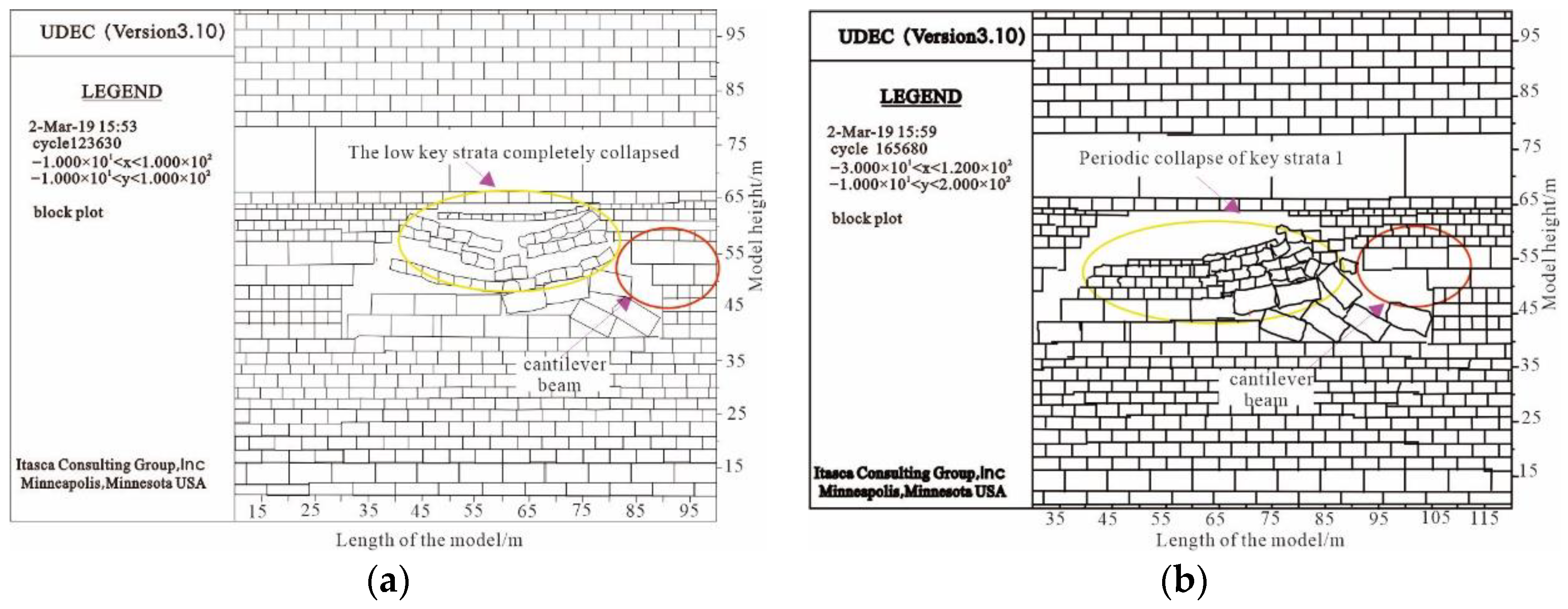

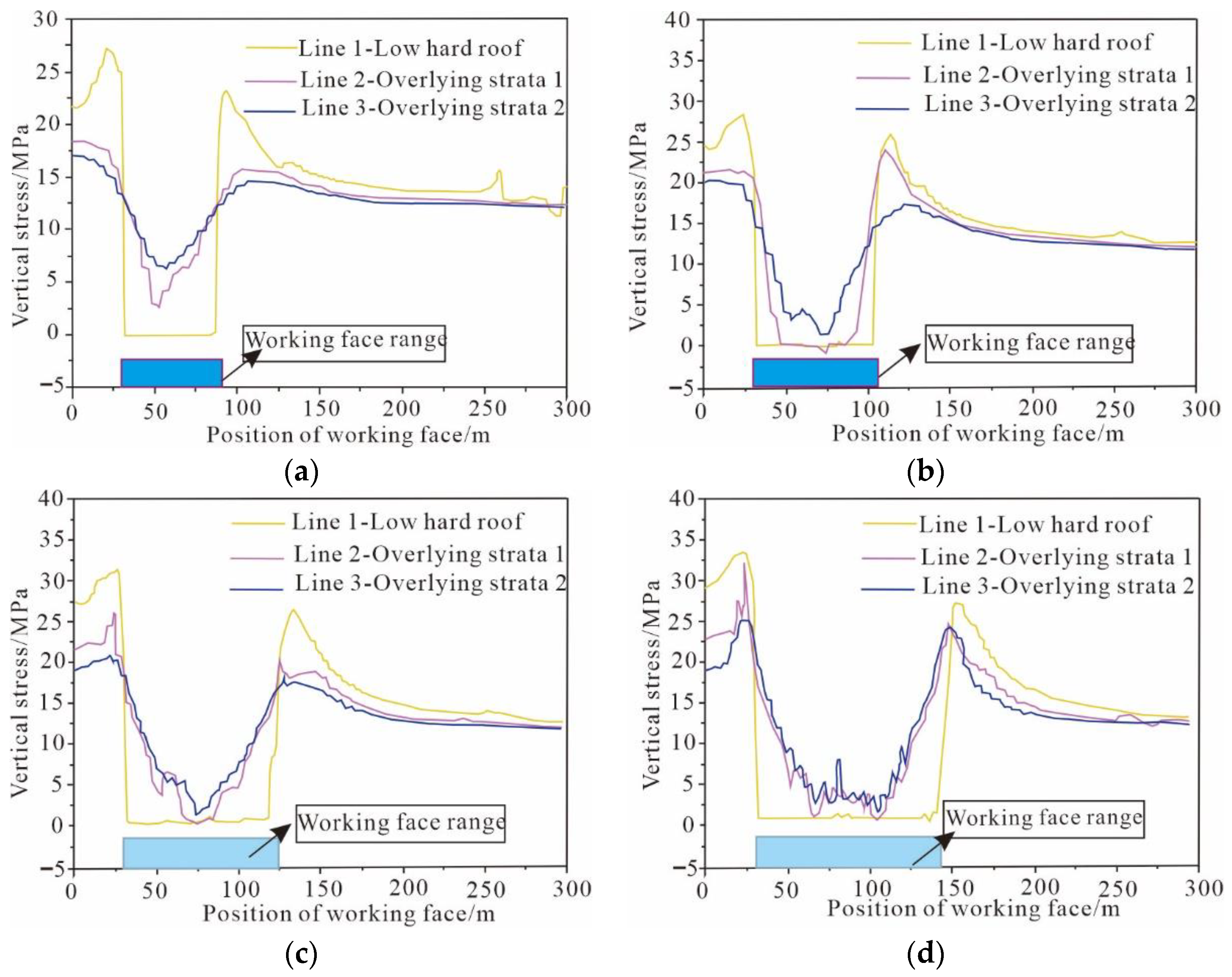
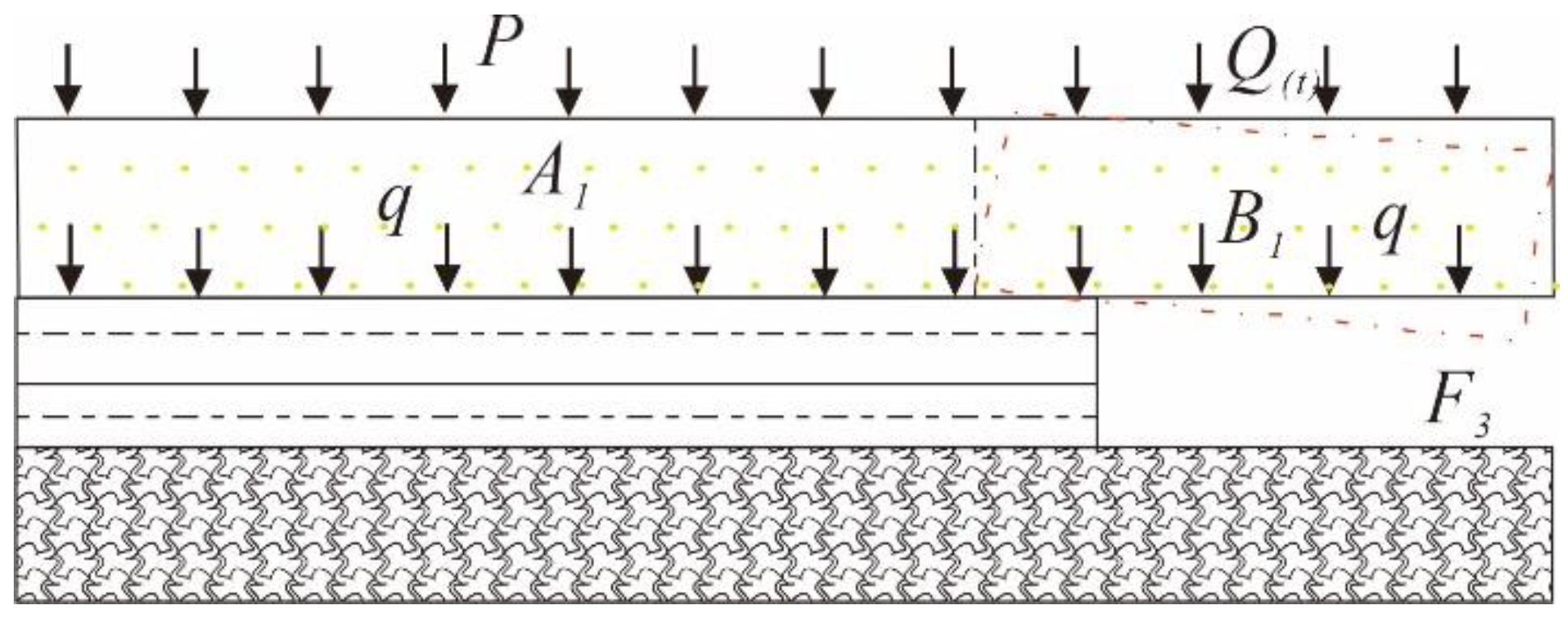
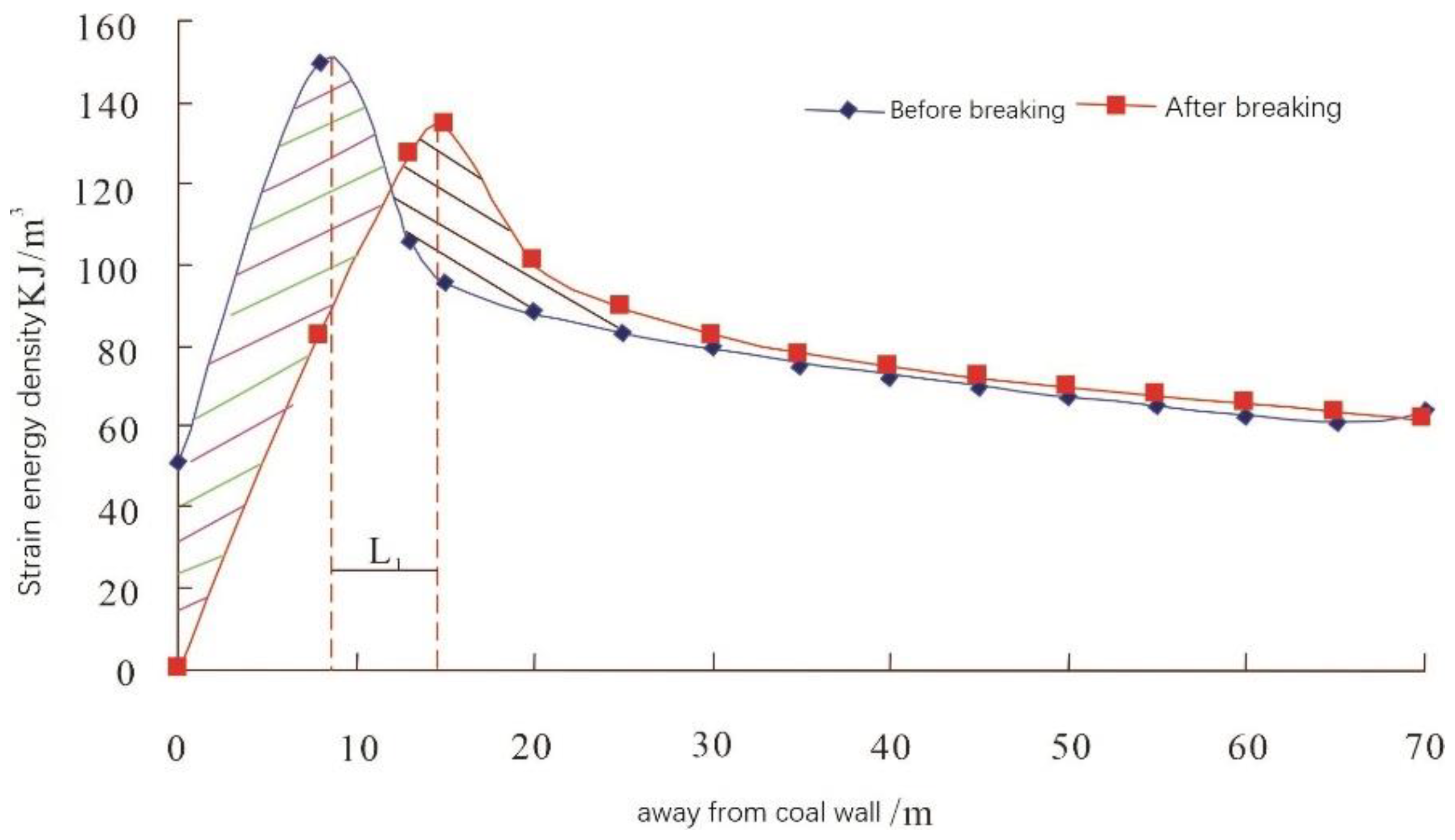
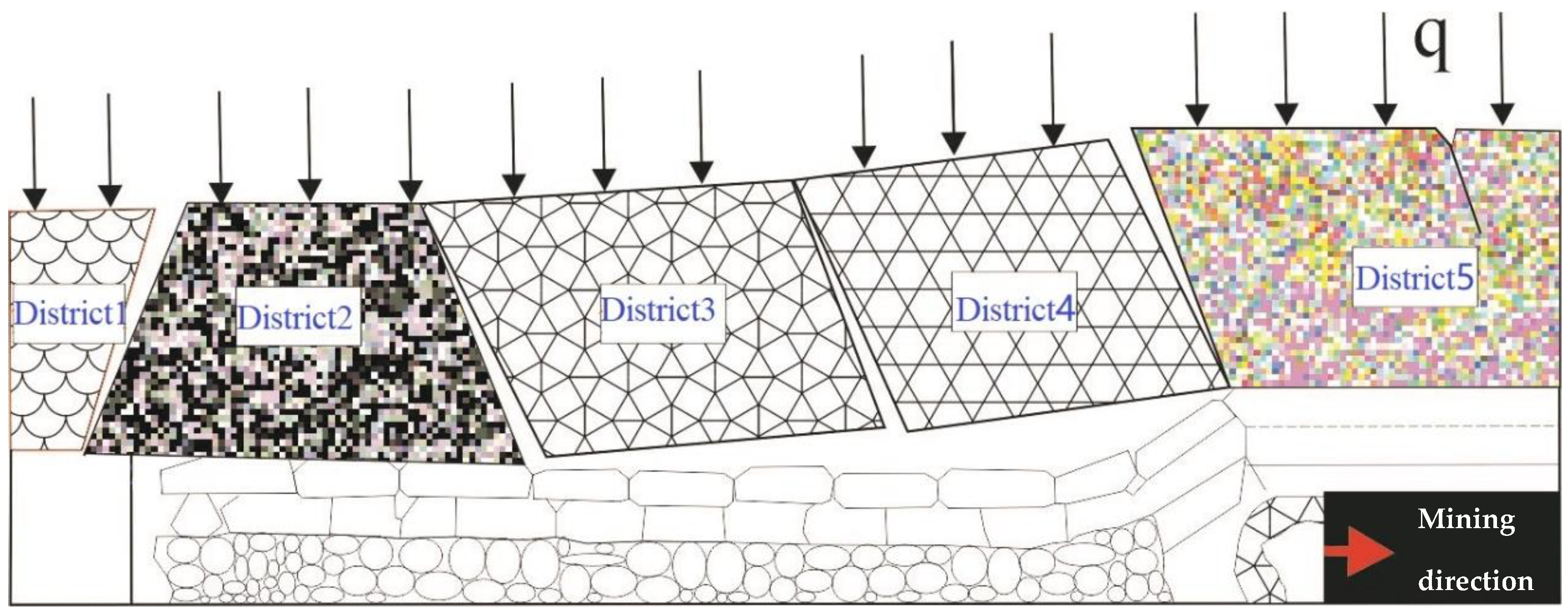
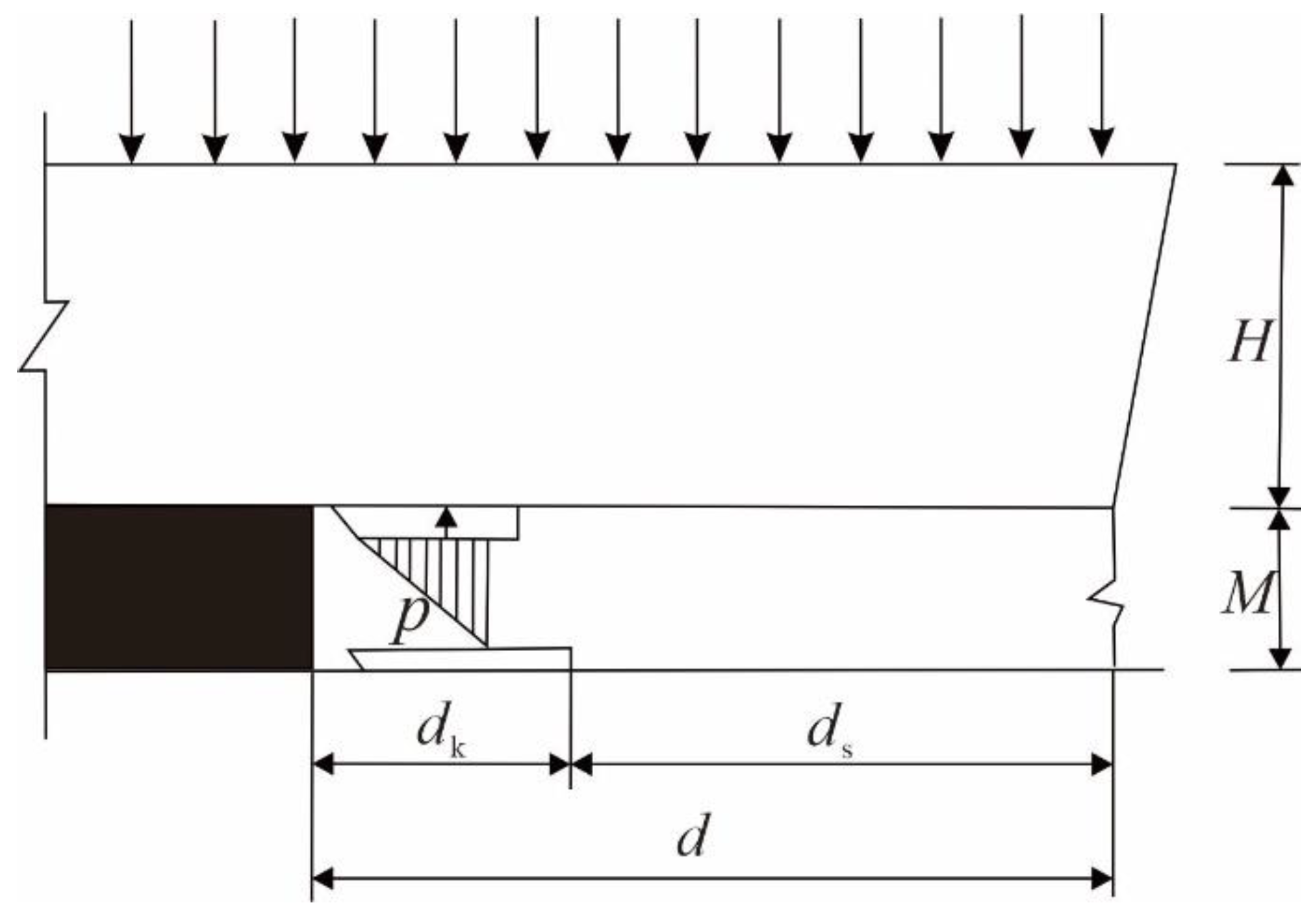


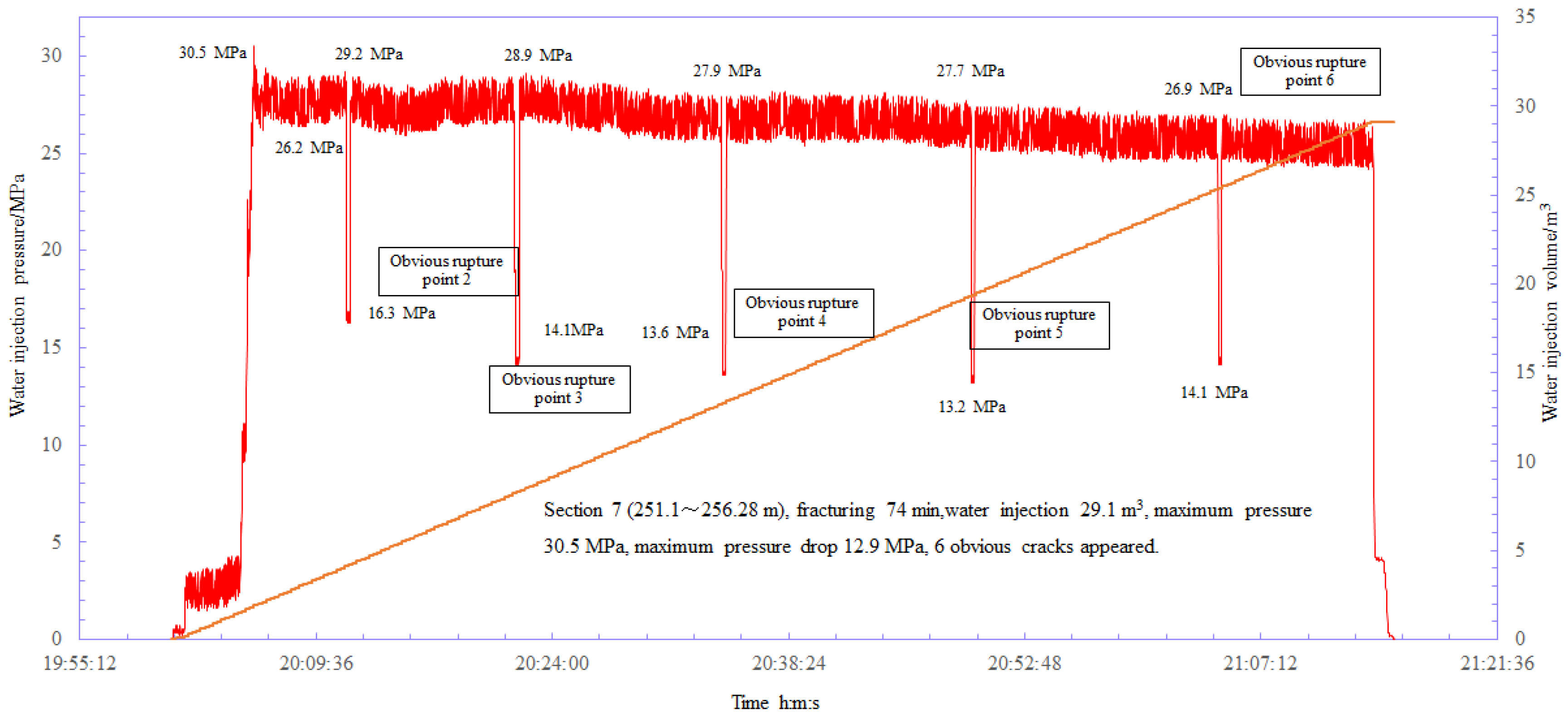
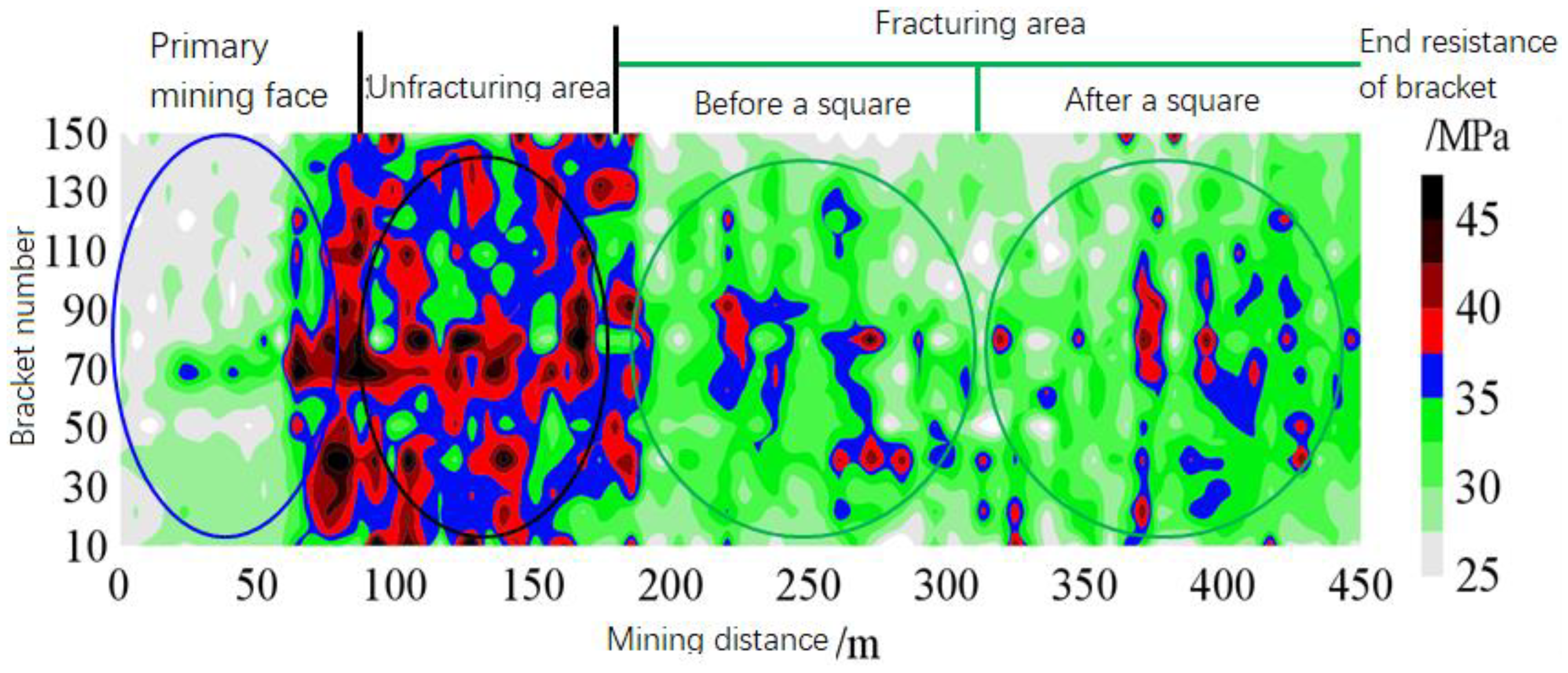
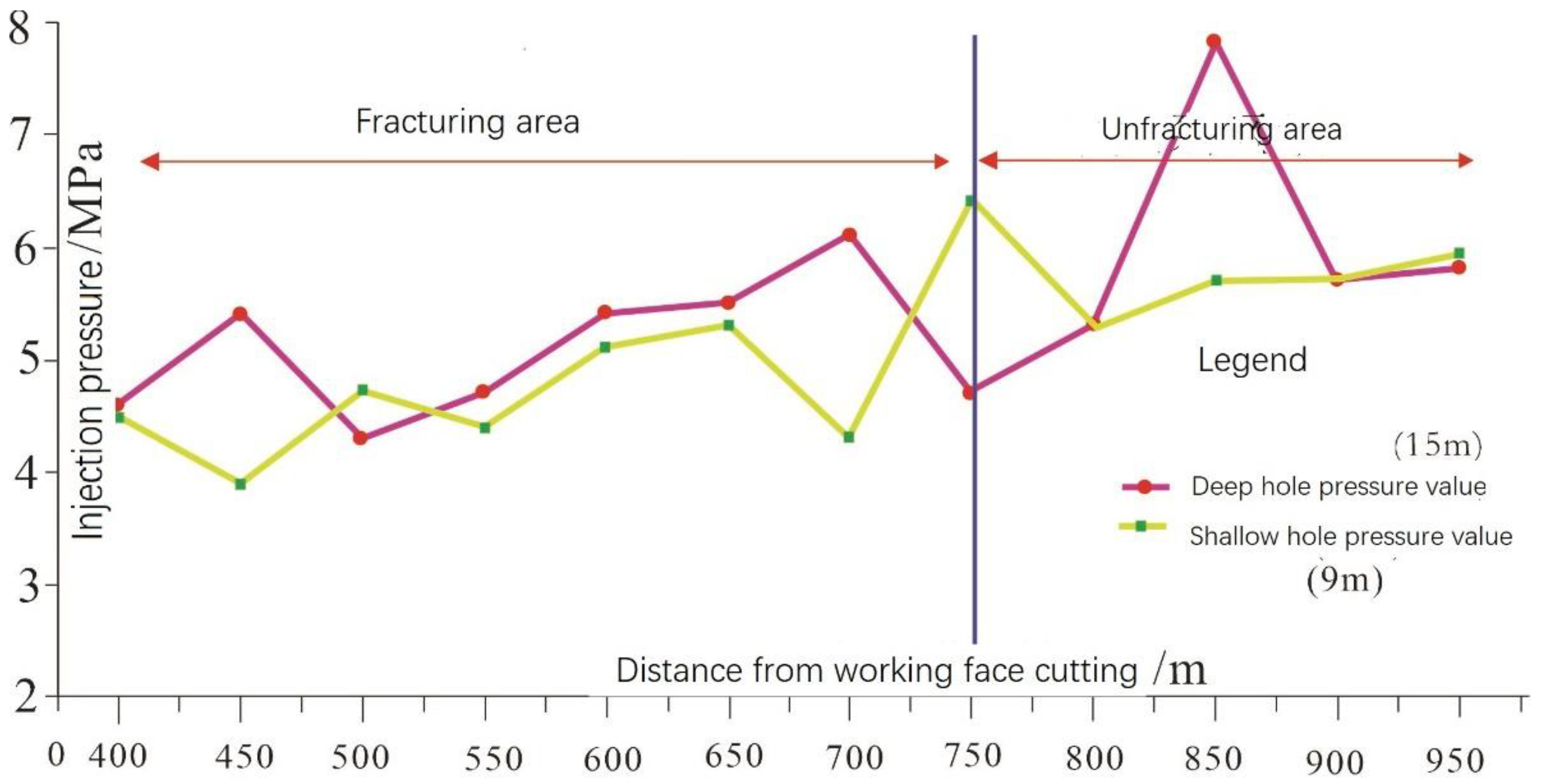

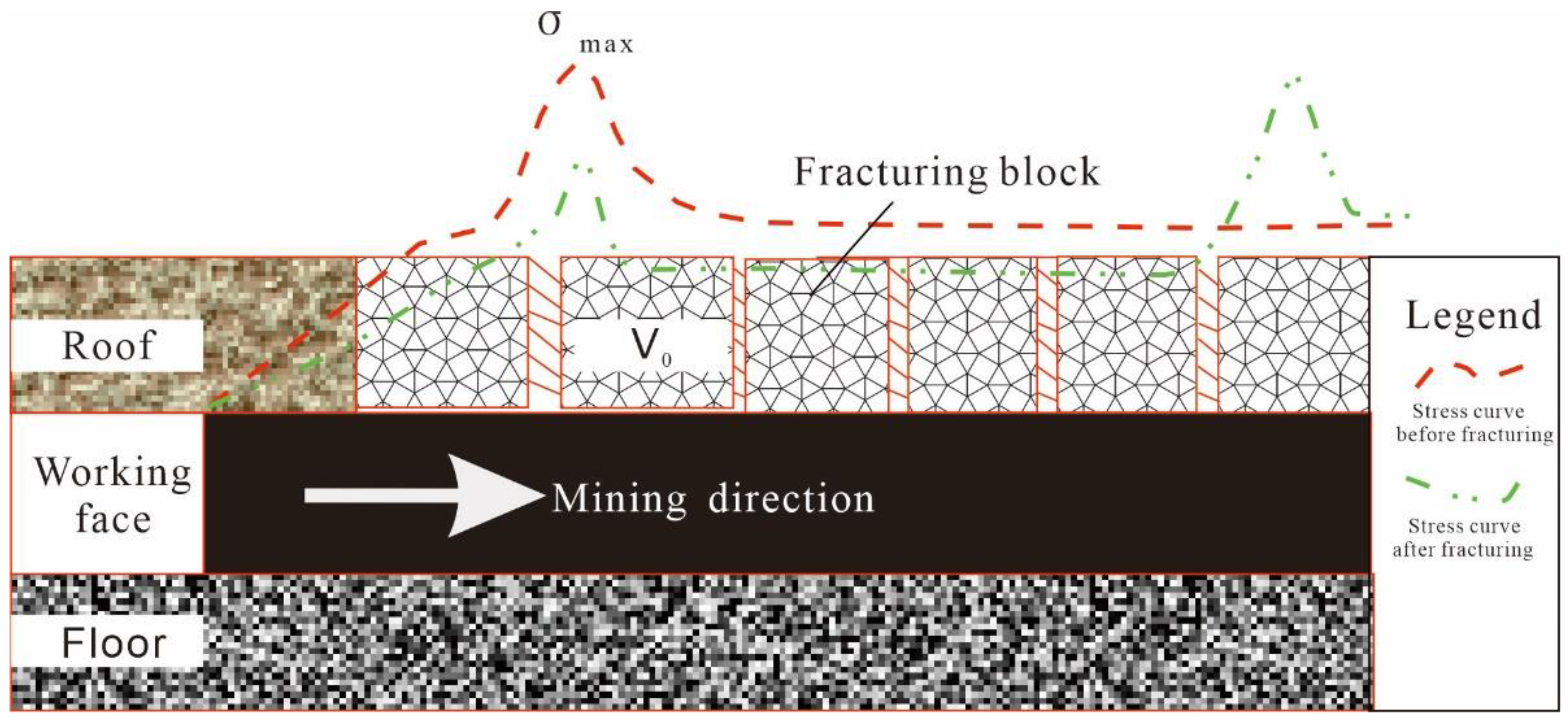
| Rock Strata | Bulk Modulus | Shear Modulus | Density | Internal Friction Anglef | Cohesive Force | Tensile Strength |
|---|---|---|---|---|---|---|
| (Gpa) | (Gpa) | (kg·m−3) | (°) | (Mpa) | (Mpa) | |
| fine grained sandstone | 14 | 10.7 | 2550 | 38 | 7.2 | 4.15 |
| mudstone | 10.65 | 7.19 | 2550 | 35 | 4 | 3.3 |
| coal seam | 6.5 | 4 | 1400 | 28 | 3.5 | 1.8 |
| No. | Lithology | Layer Thickness | Unit Weight | Tensile Strength | Elastic Modulus |
|---|---|---|---|---|---|
| (m) | (kN·m−3) | (Mpa) | (Gpa) | ||
| 11 | 1-2 upper coal seam | 1.05 | 14 | 2.13 | 2 |
| 10 | sandy mudstone | 3.39 | 26 | 2.7 | 11.9 |
| 9 | 1-2 coal seam | 0.78 | 14 | 1.68 | 2 |
| 8 | Siltstone | 18.48 | 27.1 | 5.24 | 8 |
| 7 | sandy mudstone | 7.51 | 25.5 | 3.62 | 8.6 |
| 6 | 2-2 coal seam | 2.82 | 14 | 1.17 | 2 |
| 5 | sandy mudstone | 14.2 | 25.6 | 4.21 | 8.21 |
| 4 | Medium grained sandstone | 20.89 | 26.1 | 4.45 | 8.14 |
| 3 | sandy mudstone | 14.97 | 25.4 | 1.93 | 10.99 |
| 2 | Fine grained sandstone | 22.86 | 27 | 9.26 | 14 |
| 1 | sandy mudstone | 14.43 | 26.1 | 1.52 | 10.56 |
| 0 | 4-2 coal seam | 7.23 | 14 | 1.08 | 2 |
| Stage | Steady Pressure (MPa) | Mean Pressure (MPa) | Maximum Pressure (MPa) | Dynamic Load Coefficient | Loading Distance (m) |
|---|---|---|---|---|---|
| Unfracturing area | 29.10 | 42.60 | 53.80 | 1.46 | 24.2 |
| 31.10 | 43.90 | 56.20 | 1.41 | 26.1 | |
| 29.50 | 44.70 | 59.10 | 1.52 | 25.0 | |
| 28.80 | 42.10 | 54.70 | 1.46 | 25.5 | |
| 28.10 | 41.60 | 53.80 | 1.48 | 26.3 | |
| 29.70 | 42.90 | 55.10 | 1.44 | 25.7 | |
| Mean value | 29.28 | 42.97 | 55.45 | 1.46 | 25.5 |
| Fracturing area | 27.70 | 37.50 | 50.10 | 1.35 | 18.2 |
| 28.60 | 37.70 | 46.80 | 1.32 | 16.5 | |
| 29.50 | 39.00 | 48.90 | 1.32 | 17.2 | |
| 29.10 | 39.50 | 45.60 | 1.36 | 17.6 | |
| 28.80 | 39.80 | 48.90 | 1.38 | 16.5 | |
| 30.40 | 40.60 | 47.70 | 1.34 | 17.8 | |
| Mean value | 29.02 | 39.02 | 48.00 | 1.34 | 17.3 |
| Reducing(%) | 0.88 | 9.19 | 13.44 | 5.79 | 32.16 |
Publisher’s Note: MDPI stays neutral with regard to jurisdictional claims in published maps and institutional affiliations. |
© 2021 by the authors. Licensee MDPI, Basel, Switzerland. This article is an open access article distributed under the terms and conditions of the Creative Commons Attribution (CC BY) license (https://creativecommons.org/licenses/by/4.0/).
Share and Cite
Zheng, K.; Liu, Y.; Zhang, T.; Zhu, J. Mining-Induced Stress Control by Advanced Hydraulic Fracking under a Thick Hard Roof for Top Coal Caving Method: A Case Study in the Shendong Mining Area, China. Minerals 2021, 11, 1405. https://doi.org/10.3390/min11121405
Zheng K, Liu Y, Zhang T, Zhu J. Mining-Induced Stress Control by Advanced Hydraulic Fracking under a Thick Hard Roof for Top Coal Caving Method: A Case Study in the Shendong Mining Area, China. Minerals. 2021; 11(12):1405. https://doi.org/10.3390/min11121405
Chicago/Turabian StyleZheng, Kaige, Yu Liu, Tong Zhang, and Jingzhong Zhu. 2021. "Mining-Induced Stress Control by Advanced Hydraulic Fracking under a Thick Hard Roof for Top Coal Caving Method: A Case Study in the Shendong Mining Area, China" Minerals 11, no. 12: 1405. https://doi.org/10.3390/min11121405
APA StyleZheng, K., Liu, Y., Zhang, T., & Zhu, J. (2021). Mining-Induced Stress Control by Advanced Hydraulic Fracking under a Thick Hard Roof for Top Coal Caving Method: A Case Study in the Shendong Mining Area, China. Minerals, 11(12), 1405. https://doi.org/10.3390/min11121405







